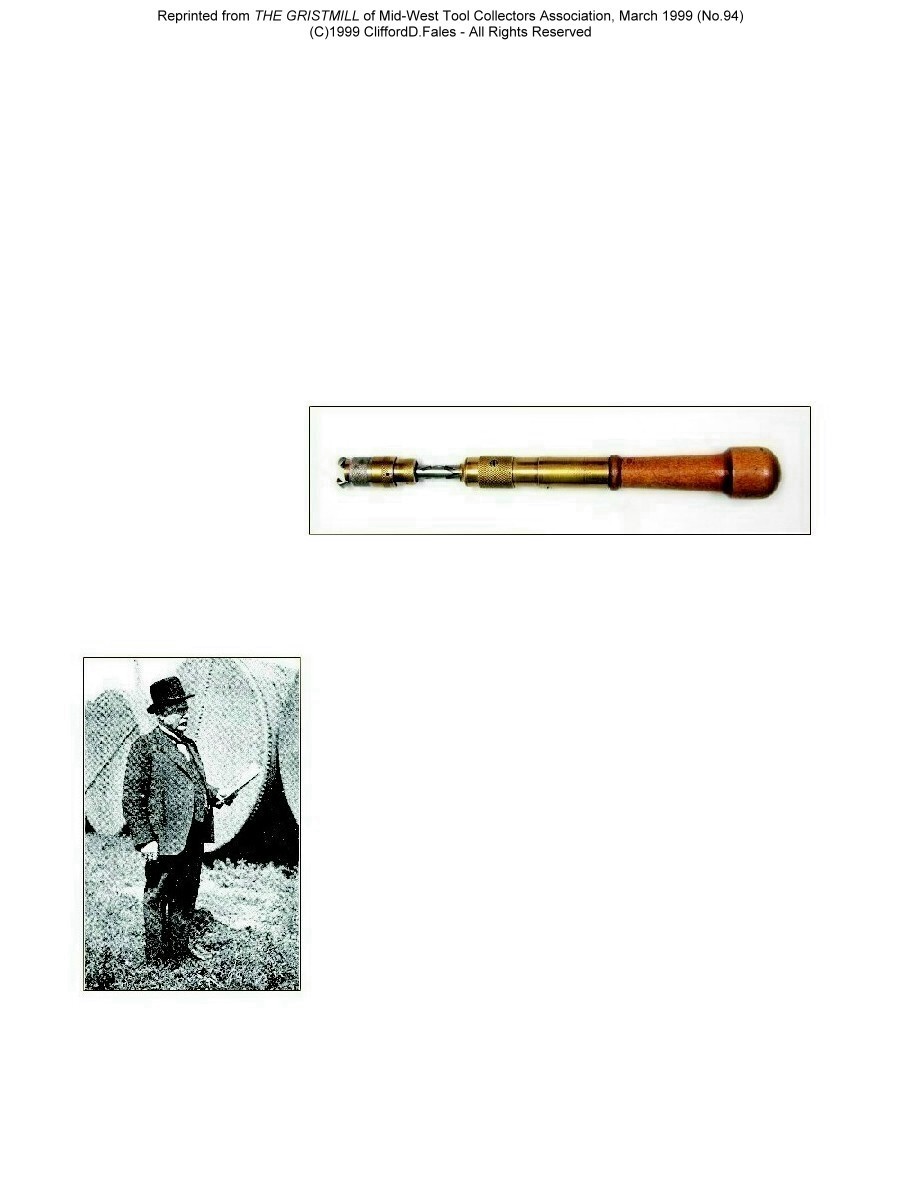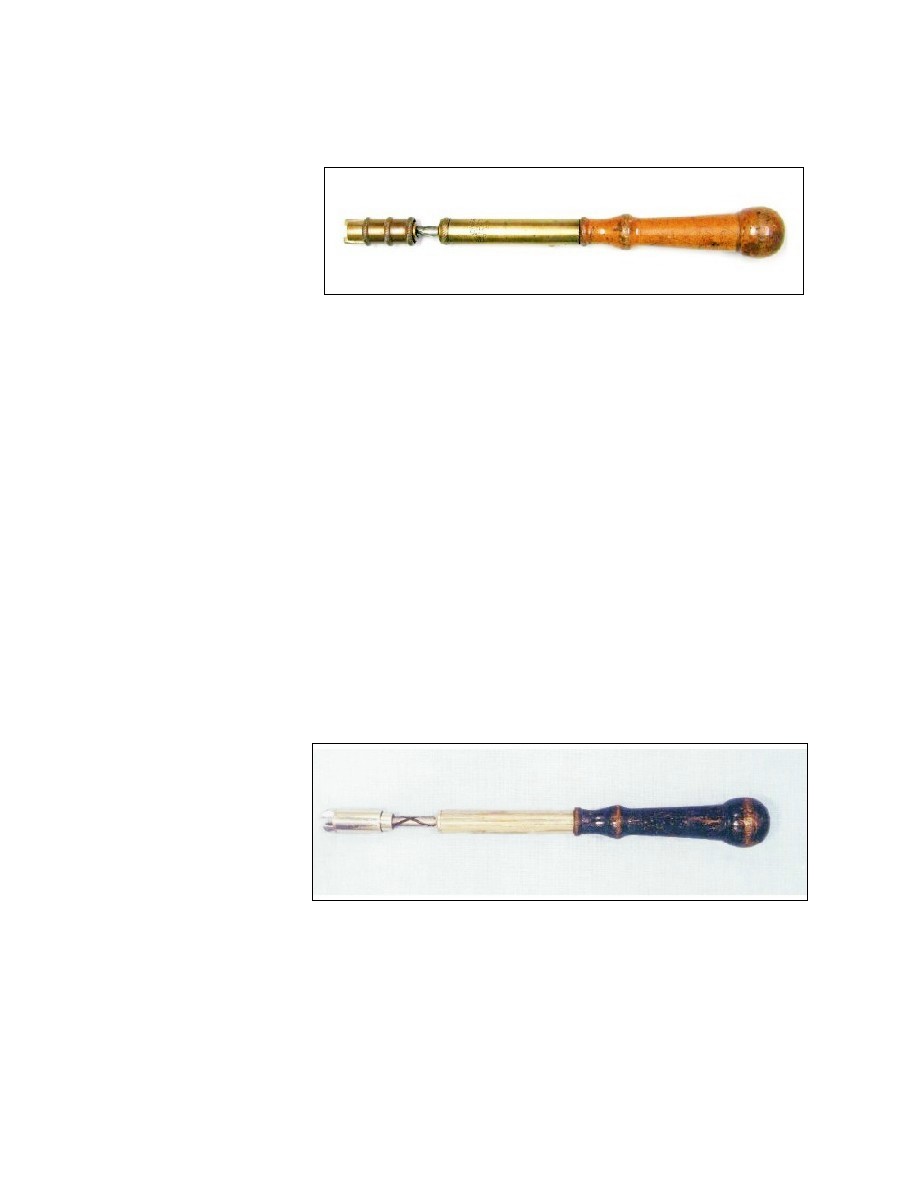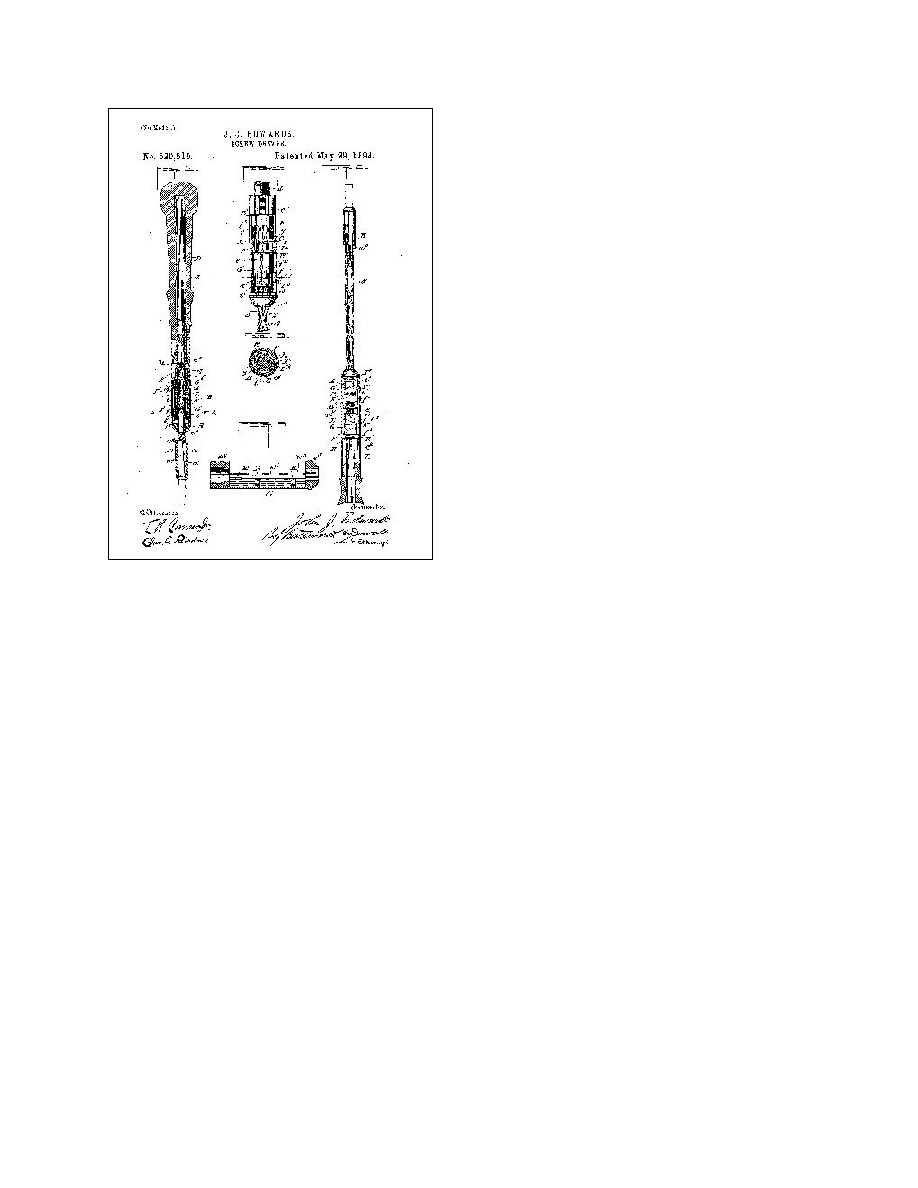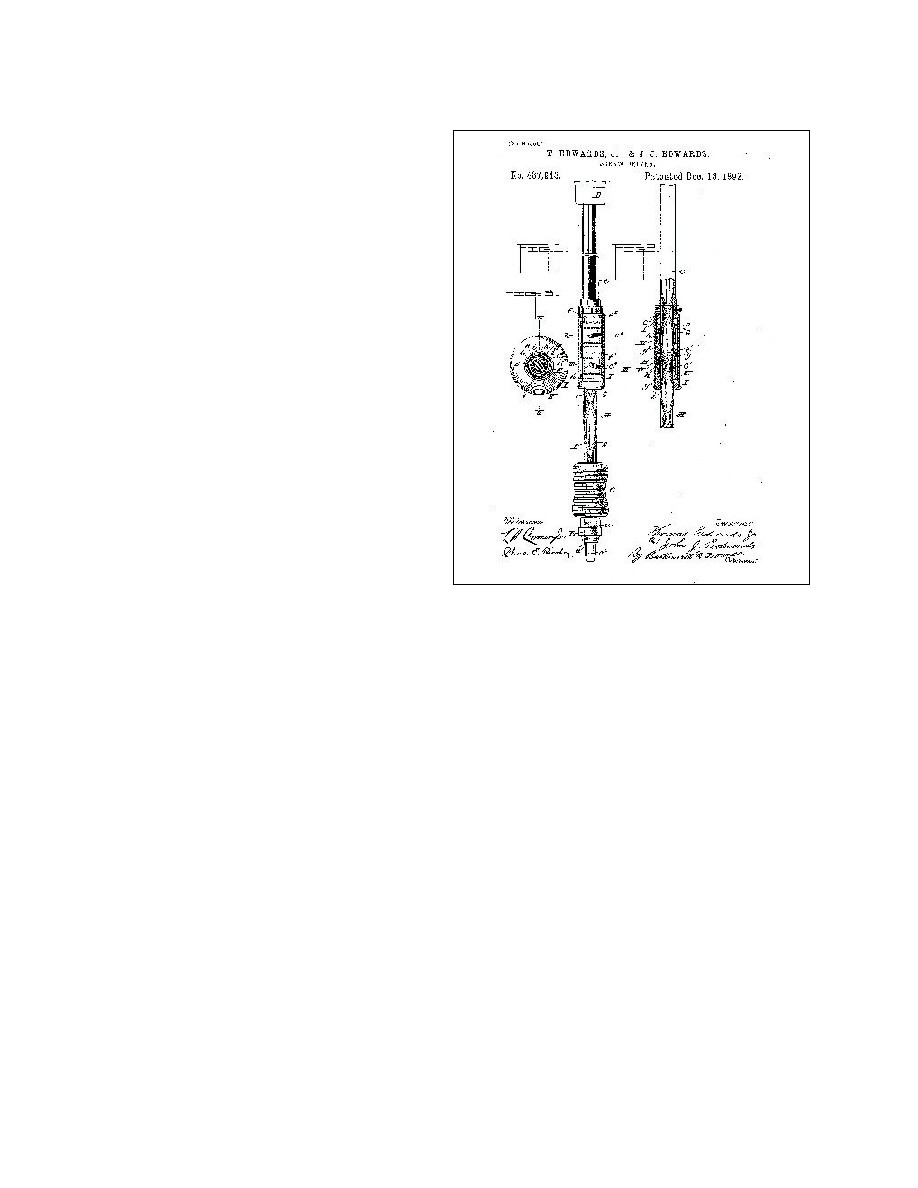
Spiral Screwdrivers of the S. F. Bowser Company
and the Universal Tool Company
_________________
By Clifford D. Fales
The company founded by Sylvanus F. Bowers in 1888 began
with an idea for what we would
now call petroleum handling equipment. The idea S. F.
Bowser conceived was for a better way of
handling and merchandising kerosene in hardware stores and grocery
stores.
At the time of his inspiration this widely used petroleum
product was dispensed by ladling by
hand from a tank in the store.
Bowser reasoned that the
kerosene could be stored in a
tank and drawn up (even from
the basement to the first floor)
by a pump –― a
self-measuring pump, at that.
This pump, as he conceived
it, would facilitate handling
by minimizing waste and
spillage as well as providing
more accurate measure. The
story is told that, after his conception of the pump, he
took orders for
the product before he had actually produced even a single unit.
The reader is referred to the article in THE GRISTMILL,
December 1986, which outlines the need perceived by
Bowser for this type of tank and pump. It continues with a
description of his oil storage tanks as being constructed of light gauge
metal enclosed in finely crafted wood boxes assembled with large
quantities of wood screws. It emphasizes the need for a sturdy tool
which surely would have facilitated the assembly of these tanks and
hypothesizes that the Bowser spiral screwdrivers came into being
because of this particular need.
After a childhood of very little schooling, a succession of
mundane jobs (including that of traveling salesman) and
poor health,
Mr. Bowser's fortune seemed to change after he gained his
inspiration and began manufacturing his self-measuring pump.
Having sold his first pumps in 1885 and obtaining his first patent for
a pump and tank in 1887, the business prospered in the last decade of
Sylvanus F. Bowser as he appeared
in an article in American Magazine
in May, 1922
Figure 1: S. F. BOWSER & CO / PAT. / FT. WAYNE, IND.
The most frequently seen Bowser spiral screwdriver, a bi-directional
model.
No relationship has been established to an actual patent.

the 19th century and well into this century. Religion
played a very large part in his life and his
philanthropy was extensive. His paternalistic attitudes and practices
toward his employees were
typical of that period in American industry.
Because of a somewhat colorful life and having made
significant contributions to his
community, a considerable amount of material was written
about the life of Sylvanus F. Bowser
and the company he established in 1888. Despite the fact that there is
a reference in some of the
Bowser biographical material that the company produced "ratchet
screwdrivers," I have been
unable to locate any advertising or catalog listings for Bowser
screwdrivers.
The company was listed in turn-of-the-century Ft. Wayne,
Indiana directories as: S F
BOWSER & CO (S F Bowser and Allen A Bowser) Patentees
and Mnfrs High Grade
Specialities, Oil Tanks, Pumps and Novelties, cor E Creighton av.
Thomas and Julia, Tel 374.
All four of the signed Bowser models studied here are
signed: S. F. BOWSER & CO. / FT.
WAYNE, IND. Additionally, each is also marked either: PAT,
PAT APPD or PAT APPD
FOR. Despite the fact that most of the Bowser screwdrivers are
consistently signed in this
manner and make a claim for being patented, none have been observed
which show a patent
date. Only one model (Example 4) appears to closely follow a known
patent.
For these reasons, and lacking catalog or advertising
documentation, it is impossible to
establish a chronological sequence or to place dates on
the manufacture of these screwdrivers
other than within the broad time period for which the Bowser company
was known to be in
business 1888 through c.1960. The order in which these four examples
are presented however,
is intended to give some indication of the frequency with which these
four models may be
encountered with the model shown as Example 1 being the most frequently
seen and the
remaining three being encountered much less often.
Example 1
Example 1 (Figure 1) is a large, sturdy reversible spiral
screwdriver. Length without the bit
is 19" extended and 12½" closed. The handle is
maple and the tube is brass without nickel
plating. Shifting is accomplished by rotating the knurled sleeve on the
outside of the tube. A
unique characteristic of this model is the chuck. Rotating the knurled
steel ring on the chuck
causes the L-shaped jaws to spread and extend outward to receive a
standard square-taper bit;
rotating the ring in the opposite direction draws the jaws downward and
together to retain the
bit. A free-turning collar behind the chuck aids in holding the bit in
place in the screw slot.
This model was probably not intended to function in a ratcheting mode.

Example 2
Example 2 (Figure 2) is
a comparably sized sturdy,
reversible screwdriver. The
handle is of a very dark
hardwood, probably
rosewood. Traces of
original nickel plating exist
on the brass tube. Shifting
is accomplished by rotating
the knurled sleeve at the
forward end of the tube.
The chuck, which has the
appearance of a miniature
bitstock chuck, accepts a standard, square-tapered bit. As in Example
1, a free-turning collar is
incorporated to facilitate holding the bit in position. Other examples
of this model have been
observed which are unsigned. As in Example 1, this model does not
function as a ratchet
screwdriver.
Example 3
Example 3 (Figure 3)
is a smaller, lighter weight
tool than any of the other
four examples and operates
only in a unidirectional,
clockwise mode; the length
is 17" extended and 11½"
closed. When turned
counter-clockwise in the
closed position the spindle
engages a positive lock;
this permits removal of
screws by functioning as a standard screwdriver. The collet type chuck
is very similar to those
on the screwdrivers of F. A. Howard, Goodell Brothers/Goodell Pratt and
early Millers Falls and
accepts the same type of bit with a round shank and a cross lip at the
inner end. Again, the handle
is of a dark hardwood, probably rosewood and traces of original nickel
plating exist on the brass
tube. There is a free turning collar behind the chuck for guiding the
bit. There is no ratchet
function for this model.
Figure 2: S. F. BOWSER & CO / PAT APPD FOR / FT.
WAYNE, IND.
A seldom seen bi-directional Bowser spiral screwdriver. No relationship
has been
established to an actual patent. (Courtesy of William T.
Wilkins)
Figure 3: S. F. BOWSER & CO / PAT APPD / FT. WAYNE,
IND.
A less commonly observed, clockwise-only Bowser spiral screwdriver.
No relationship has been established to an actual patent.

Example 4
Example 4 (Figure 4) is
a reversible model and the
largest of these four models.
Length without the bit is
20¼" extended and 14"
closed. The handle is maple
and the tube is brass without
nickel plating. Shifting is
accomplished by rotating
the entire brass sleeve in
front of the handle. As
claimed in the patent, the mechanism does lock both clutches to permit
operation as a fixed
screwdriver. It also permits operation as either a clockwise or
counterclockwise ratchet
screwdriver. It does not have a free turning collar to assist in
holding the bit in place against the
screw. While most aspects of this model follow very closely J. J.
Edwards' 1894 patent
illustration (Figure 5), the chuck differs completely. It is made
entirely of brass even the jaws
which hold a standard square-taper shank rather than a
dedicated/proprietary bit as shown in the
patent illustration. The patent (Figure 6) which appears to be the
basis for this model was
assigned to S. F. and Allen A. Bowser. Because of the availability of
the claim in a matching
patent, it can be stated that this model is intended to also function
as a ratchet screwdriver.
However, this function is less than optimal as the handle rides up on
the spiral when turning on
the driving stroke a difficulty overcome later by other manufacturers.
The patent also makes a
claim for a spindle lock, but this feature is not reliable in my
example since the required setting
of the shifter is very difficult to achieve.
Example 5
Although not signed
as S. F. Bowser, this
example, (Figure 5),
shows so much similarity
to Example 4 that it surely
was manufactured by the
Bowser company or
whoever carried out the
manufacture of the Bower
screwdrivers. It is a
reversible model, very
similar in size, design and
function, to Example 4,
but signed by the
Universal Tool Co. of
Grand Rapids, Michigan.
Figure 4: S. F. BOWSER & CO / PAT'D. / FT. WAYNE, IND.
Another seldom seen, bi-directional Bowser spiral screwdriver based on
the 1894
patent of J. J. Edwards of of Grand Rapids, Michigan.
Figure 5: UNIVERSAL TOOL CO. / GRAND RAPIDS, MICH. /
UTCO. / PATD.
DEC. 13, 1892 / PAT APD FOR
A bi-directional spiral screwdriver, very similar to Bowser/Figure
4, ambiguously
attributed to the 1892 patent by Thomas Edwards Jr. and J. J. Edwards
of Grand
Rapids, Michigan. (Courtesy of Howard Mironov)

The handle is maple, but in this case with a
black, ebonized finish. The tube, chuck and
chuck collar are nickel plated brass. Shifting is
accomplished exactly as in Example 4. Other
features are similar to those of Example 4. While
the exterior appearance of the chuck is different
from Example 4, its function and operation is
similar and it also holds a standard square-taper
bit. Ratcheting and shaft-locking functions are
similar to those of Example 4.
The only characteristics of Example 5 which
differ from Example 4 are: a lack of knurling on
the chuck lock, the shape of the chuck jaws, the
shape of a the plug at the outer end of the tube, a
machined tube, an ebonized finish on the handle
and nickel plating on the brass tube.
There is a contradiction here in that, while
this model follows so closely the construction of
Example 4 and the 1894 J. J. Edwards patent (Fig.
6), it bears a different patent date Dec. 13, 1892.
A patent by T. Edwards, Jr. and John J. Edwards
of the date indicated on the tool does exist (Figure
7), but it does not appear to be the basis for this
tool. However, the patent granted solely to John J.
Edwards (Figure 6), No. 520,519 of May 29,
1894, appears to be the basis for this screwdriver
as well as for Example 4. Furthermore, this patent was
assigned to Sylvanus F. Bowser and
Allen A. Bowser of Ft. Wayne, Indiana.
The inclusion of PATD APPD FOR in the mark, as well as PAT
DEC 13, 1892, may imply
that this model was manufactured prior to 1894 and that a
future patent was anticipated for one
or more individual features of this screwdriver which actually did
occur in the 1894 patent.
Still Another Edwards Patent
Yet another spiral screwdriver patent (No. 568,341 of
September 29, 1896) was granted
Thomas Edwards, Jr. and John J. Edwards (Grand Rapids,
Michigan) for a right-hand-only
model.
The fact that this patent is for a clockwise-only model
and the fact that the appearance of the
chuck is similar to that of Example 3 offer only a small
amount of evidence that it could relate to
the present Example 3 of the S. F. Bowser Co.
Figure 6: John J. Edwards patent No. 520,519 of May
29, 1894 which was assigned to Sylvanus F. Bowser
and Allen A. Bowser. This patent appears to be the
basis for Examples 4 and 5.

Neither the 1892 nor the 1896 patent
indicates an assignment to Bowser as does
the 1894 patent. Due to the lack of evidence
showing a relationship of the 1896 patent to
screwdrivers with the Bowser name, the
patent illustration has not been included here.
Internal Factory Tool or
Publicly Available Tool?
The information available is not
sufficient to clearly establish whether these
spiral screwdrivers were used only in-house
for the Bowser manufacturing processes or
whether they were actually sold to the public.
It is known that the company did manufacture
products at some periods of their history
other than the petroleum handling equipment
for which they were best known. In addition
to ratchet screwdrivers mentioned above
(which very well could be a loose
interpretation by a business writer or
reporter) the company is known to have
manufactured products for the consumer
market roller skates, wash boards and dust
pans.
The fact that no advertising material has
turned up would argue that these tools were indeed created
for internal factory use. On the
contrary, considering the fact that Example 1 is not extremely scarce
tool among collectors, the
other argument could be made that the number of them existing today is
more that would have
survived if made only for internal use in the Bowser factory.
A Connection between Grand Rapids and Ft. Wayne?
Although it can only be conjectural at this point, there
must have been a business
relationship between Sylvanus F. Bowser (of Ft. Wayne,
Indiana) and John J. Edwards and
Thomas Edwards, Jr. (of Grand Rapids, Michigan), the two different
locations notwithstanding.
The marked similarities in design, manufacture and
operation among Example 4, Example 5
and the Edwards 1894 patent have been noted. The
assignment of the patent by Edwards to the
S. F. Bowser and his nephew, Allen A. Bowser has also been noted.
The fact that John J. Edwards's place of residence at the
time of his patent coincided with its
rapid expansion as a center of furniture manufacture makes
it reasonable to envision that Grand
Figure 7: Thomas Edwards, Jr. and John J.
Edwards' patent No. 467,946 of December
13, 1892. Although not matching the tool,
this is the patent date marked on Example 5.

Rapids and this industry might have nurtured the
development of this type of tool. Evidence of
this exists in that one of the witnesses to his 1894 patent has been
documented as a director of a
Grand Rapids furniture manufacturing firm in 1881. The need for a tool
of this type in the
manufacture of furniture would have been very similar to that of the S.
F. Bowser company and
may have led to some sort of collaboration between persons involved in
these two industries.
With the emerging evidence that these individuals and
companies were related it may be
possible that the Bowser screwdrivers, even though signed
with the Ft. Wayne location, were
made in Grand Rapids for the Bowser company.
_______
Any additional information from readers concerning S. F.
Bowser & Co., The Universal
Tool Co. or their spiral screwdrivers, will be appreciated
by the author.
Acknowledgments
Allen County (Indiana) Public Library
The Allen County-Fort Wayne (Indiana) Historical Society
Grand Rapids (Michigan) Public Library
Howard Mironov
O. M. Ramsey
William Wilkins
References
Ramsey, O.M. "A Bowser Screwdriver" The Gristmill 46.4
December (1990): 23
Rhodes, John Kidder, "A Story That Makes You Take A New
Grip on Yourself" American
Magazine, 93 May (1922): 46-47,183-184
Pierard, Richard V. Sylvanus F. Bowser, Ft. Wayne: The
Allen County - Fort Wayne Historical
Society, (1960)
History of Kent County, Michigan, Chicago, C. C. Chapman
(1881): 908
©1999 Clifford D. Fales - All Rights Reserved






